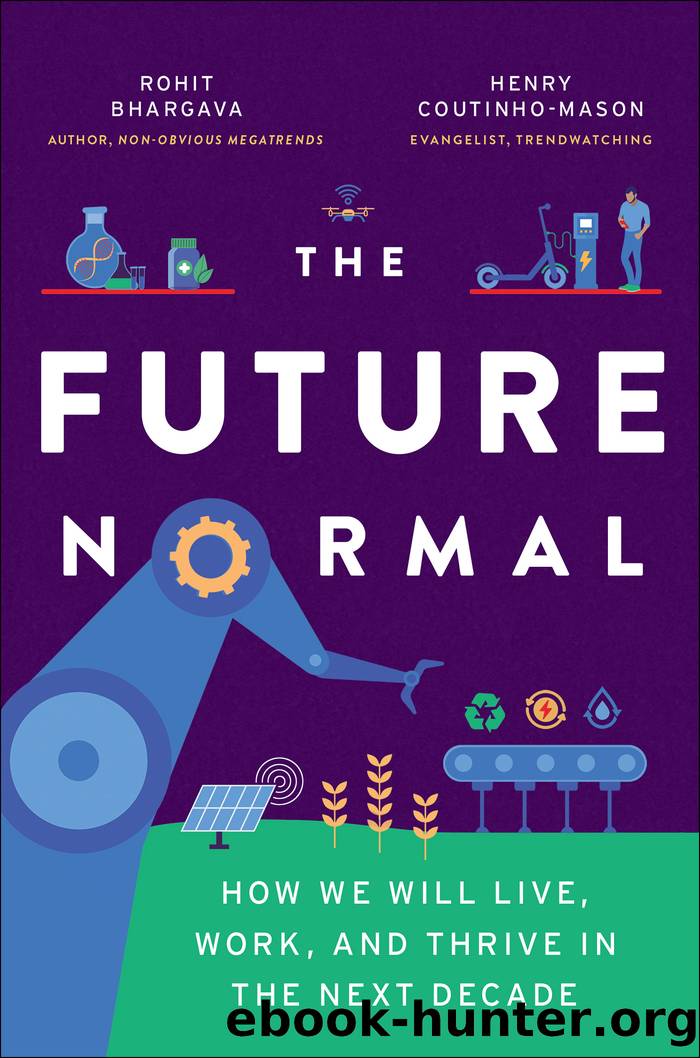The Future Normal by Rohit Bhargava & Henry Coutinho-Mason

Author:Rohit Bhargava & Henry Coutinho-Mason [Bhargava, Rohit & Coutinho-Mason, Henry]
Language: eng
Format: epub
Publisher: Ideapress Publishing
Published: 2023-02-13T20:00:00+00:00
Imagining the Future Normal
What if we based our assessment of the effectiveness of government on what happens locally in our communities?
How could good governing initiatives that work in one region be shared and implemented in another?
How might we each measure and increase our personal civic engagement beyond simply casting a vote?
CHAPTER 23 THE 15-MINUTE CITY
What if every long journey in the city was cut to 15 minutes?
When Carlos Moreno met with Paris Mayor Anne Hidalgo as she prepared her reelection campaign, he was expecting his ideas to âbe a paragraph down the bottom of the campaign leaflet.â1
Moreno, a professor of complex systems at Paris-Sorbonne University, is the mastermind behind the â15-minute cityââthe notion that city residents should be able to get to the places they access dailyâfrom workplaces to stores to schools and universities to health-care providers to cultural and green spacesâwithin a quarter of an hour. In a TED Talk where he lays out his novel idea, he argues that our cities are âbubbles of illusory acceleration.â2 While we think of megacities as fast paced, the mundane reality is that cities are characterized by long, wasteful commutes that damage the environment, are terrible for personal and collective well-being, exacerbate inequality, and entrench injustice.
So, Moreno asked: What if this changed? What if we could exponentially increase the range of services we could access within 15 minutes?
Morenoâs ideas became central to Hidalgoâs successful reelection campaign and her vision of Parisâs future. Walk around the newly renovated Minimes barracks, a 1920s complex in the Marais district of Paris, and you get a sense of what that future might look and feel like. The public housing complex features commercial office space, a number of small artisan workshops, a nursery for childcare, a health clinic, and a café staffed partially by people with autism. The central courtyard, formerly its parking lot, has been converted into a public garden. As a result of the Paris 2024 Olympics, similarly ambitious developments are underway in the Seine-Saint-Denis region, described as âthe most youthful and cosmopolitan department in France.â3 The Summer Games in particular have provided the inspiration for the Paris 2024 organizing team to focus beyond building venues to the long-term legacy of the city. Already declaring that 85 percent of competition venues will be located under 30 minutes from the Olympic Village, the city is making significant investments in public transportation and zero-emission transit options that will transform it for the long term.4
Paris may seem like an extreme example. After all, most cities canât rely on the boon of Olympic-level development budgets, but there is another way to create the 15-minute city, beyond reconfiguring the structure of the city to ensure amenities are physically present in local districts, as in the Minimes barracks. Making people more mobile enables them to access a greater range of their citiesâ amenities in less time. This approach is far more practical for most cities given the next generation of âmicromobilityâ vehicles. While the past 15 years have seen impressive urban
Download
This site does not store any files on its server. We only index and link to content provided by other sites. Please contact the content providers to delete copyright contents if any and email us, we'll remove relevant links or contents immediately.
Hit Refresh by Satya Nadella(8331)
The Compound Effect by Darren Hardy(7546)
Change Your Questions, Change Your Life by Marilee Adams(6637)
Nudge - Improving Decisions about Health, Wealth, and Happiness by Thaler Sunstein(6629)
The Black Swan by Nassim Nicholas Taleb(6184)
Daring Greatly by Brene Brown(5636)
Deep Work by Cal Newport(5452)
Principles: Life and Work by Ray Dalio(5315)
Rich Dad Poor Dad by Robert T. Kiyosaki(5140)
The Myth of the Strong Leader by Archie Brown(4786)
Man-made Catastrophes and Risk Information Concealment by Dmitry Chernov & Didier Sornette(4729)
Big Magic: Creative Living Beyond Fear by Elizabeth Gilbert(4719)
The Slight Edge by Jeff Olson(4716)
Discipline Equals Freedom by Jocko Willink(4631)
The Motivation Myth by Jeff Haden(4521)
Digital Minimalism by Cal Newport;(4512)
Stone's Rules by Roger Stone(4413)
Management Strategies for the Cloud Revolution: How Cloud Computing Is Transforming Business and Why You Can't Afford to Be Left Behind by Charles Babcock(4127)
The Doodle Revolution by Sunni Brown(4036)
